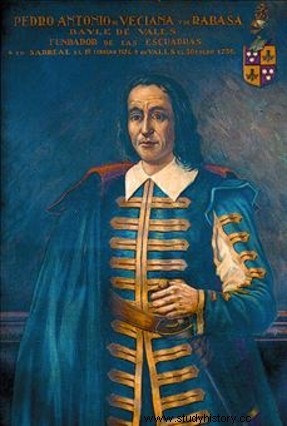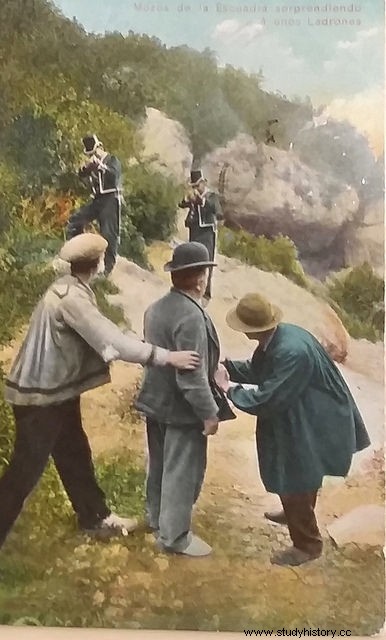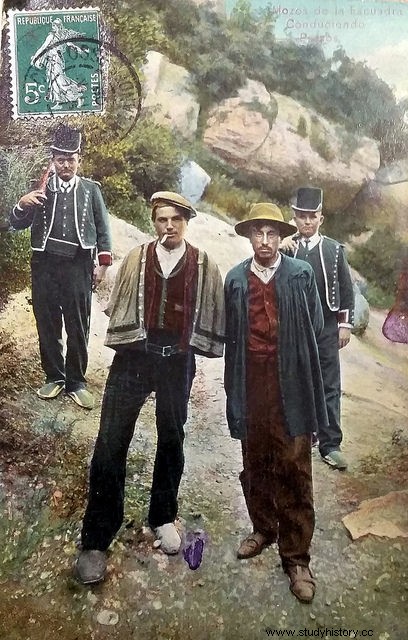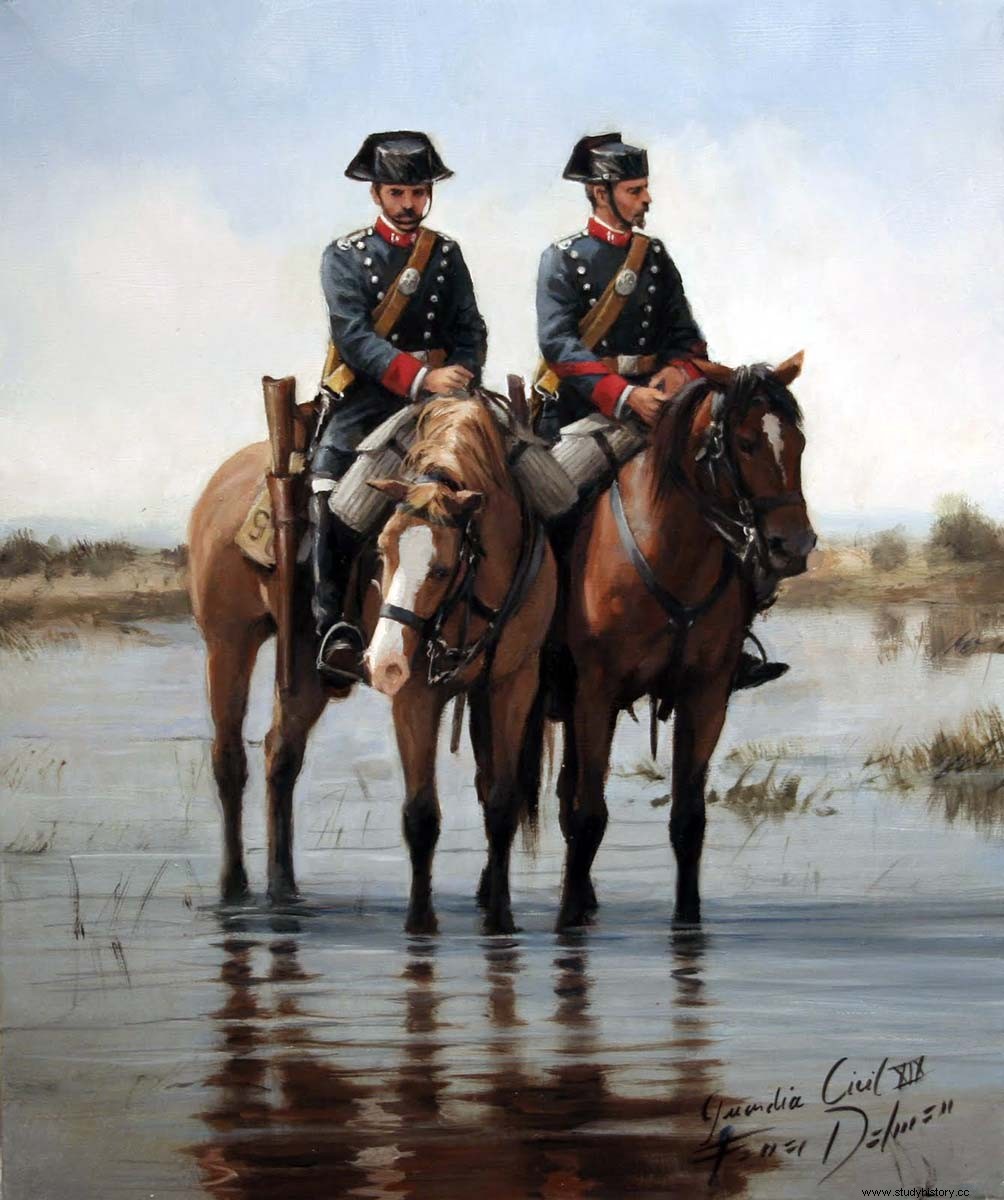This is the history and origins of the Mossos d'Esquadra and the Civil Guard . The Mossos d'Esquadra were designed and created by King Felipe V with a dual purpose:to stop the criminals and bandits who were scattered throughout the towns, roads and mountains in Catalonia, and to put an end to the Austrian supporters after the end of the War of the Spanish Succession, who intended to support an invasion of Spain by various European nations in favor of Archduke Charles of Austria. The Austrians, also known by various nicknames as «imperial » or «eaglets » among others, were the rivals of the Bourbons , «felipistas » or «botiflers «. This war confronted not only the supporters of one side or another on Spanish soil, but also the interests of other European states, such as, among others, the Holy Roman Empire, Great Britain, Portugal, Holland... (Austracists) and France , the Duchy of Mantua, the Archbishopric of Cologne… (Bourbons).

Pere Antoni Veciana i de Rabassa
The first mention of the term «mosso » or «square » appears in the year 1719, in Valls, Tarragona. The priority of this first "squad" was to persecute the Austrian remnants that remained in Catalonia, known after the siege of Barcelona as "herois del 1714 » and who desperately sought the support of the other allied states. The founder of the Mossos was the Captain General of Catalonia Francisco Pio de Saboya y Moura ,Marquis of Castell Rodrigo, Italian soldier who fought under Philip V, and the first head of the Mossos was Pere Antoni Veciana i de Rabassa , mayor of the town of Valls, whose family would command the body until approximately 1836. Although the War of Succession ended with the signing of the treaties of Utrecht (Holland) in 1713 and Rastatt (Germany) in 1714, the hostilities in Spain they did not stop until the year 1715. As curious notes, this first squad was made up of a first commander, a second, fourteen corporals and one hundred and five young men or "mossos".


The history and origins of the Civil Guard in Spain are more recent in time. Although banditry was a problem in Spain since Roman times -Viriato type- and it spread even more during the Muslim period, the time that exceeded the limits seen previously was the War of Independence (1808 - 1814). At the end of the war against the Grande Armeé of Napoleon and overthrow his brother from the Spanish throne, many deserters, criminals and ex-combatants, unable to adapt to civilian life, chose to disperse in the most rugged areas of the Peninsula. The guerrilla as a way of confronting the French troops had been a common and effective method:a group of armed men waited in ambush for the enemy to attack him and, without giving them time to react, causing numerous casualties and quickly escaping. This guerrilla tactic was already common in Roman Hispania, where Viriato was a clear example of the mastery of the ambush. Thus, the word «bandolero » is a term that comes from «bando «; bandolero is that subject that appears in a search and capture band. This period left names of some well-known bandits, such as «el Tempranillo «, Juan Palomo… or the real bandit on which the protagonist of the series Curro Jiménez is inspired , Andrés López Muñoz , the «boatman from Cantillana «. Given the threat and seriousness of this phenomenon, an attempt was made to create a national police force to ensure public safety; problem to which the progressives of the Cortes of Cadiz responded by reunifying the national militia. With the arrival of one of the worst kings in the history of Spain, Fernando VII, the militia was dissolved, and would be constituted again in 1820 under the name of «Realist Volunteer Corps «. Years later, Lieutenant General Pedro Agustín Girón y de las Casas , the first Duke of Ahumada and with liberal ideas, was appointed Minister of War. From his position as minister he devised a project inspired by the French Gendarmerie of what would be the future Civil Guard, an armed institute for the maintenance of public order called Legion of National Safeguards with the functions of combating crime and guaranteeing the free movement of goods and people in Spain.

Pedro Agustín Girón and de las Casas
This project would not see the light of day until years later, when Francisco Javier Girón y Ezpeleta , the second Duke of Ahumada, under the protection of Queen Isabel II, created the first body of the Civil Guard known in the history of Spain made up of 14 chiefs, 232 officers and 5769 agents, divided into 14 thirds in homage to the armies of the Austrians. The second Duke of Ahumada is not only the founder of the body, he is also the moral support of the Civil Guard. In 1845 he created the Civil Guard booklet , the moral code for agents and whose main motto would be «honor is my motto «. The green uniform and the tricorn, of French origin, became distinctive symbols of this body. Some of the articles included in said primer…
-Art.1:The honor must be the main currency of the Civil Guard, must therefore keep it spotless. Once lost, it is never recovered.
-Art. 3:Harassment, bad words, bad manners, should never be used by any individual who wears the uniform of this honorable body.
-Art. 34:In the event of a fire, he will go immediately to the point where it occurs, taking special care to protect all the people who are at the site of the misfortune, ensuring their interests and preventing people from entering the house who, with the pretext of auxiliary, they carry the pretext of stealing or committing other excesses.
-Art. 35:In the floods of rivers, hurricanes, earthquakes or any other calamity, he will provide whatever aid is within his reach to those who are involved in these evils.

Carrying out its functions under these and other rules reflected in said primer, the Civil Guard prevailed over bandits, smugglers, anarchists, criminals... and survived changes of government, dynastic changes, changes of political regime... achieving public and social recognition, in addition to being worthy of the numerous crosses of the Civil Order of Charity (created by Royal Decree of May 17, 1865) for the humanitarian services rendered. It is from these crosses of the Civil Order of Beneficence and from this public and social recognition that the term by which the Civil Guard is also known, la Benemérita derives. .
After the Spanish Civil War, the Civil Guard underwent a profound reform; it absorbed the Police Corps and the military regulations and the regulations for service were approved simultaneously in 1942, thus allowing it to preserve its meritorious character. Some articles of said regulations varied, others were preserved. As an example, the first article of the service regulations is the same as that of the 1845 primer, while the first article of the military regulations is that «the special mission is to watch over people and property «.
As a final note and for those who know Law, in the current constitutional stage the Spanish State is configured as a social and democratic State of Law, for which the Civil Charity Order has been repealed in accordance with Royal Decree 407/1988 of 22 April, which regulates the Civil Order of Social Solidarity at the proposal of the Ministry of Labor and Social Security (B.O.E. No. 104 of April 30, 1988). The decorations that substitute the previously mentioned ones of Charity are currently regulated by the regulations of the Civil Order of Social Solidarity, approved by Order of April 17, 1989 of the Ministry of Social Affairs (B.O.E. No. 102 of April 1989).
Although some time has passed since the creation and disappearance of the Order of Charity, nothing prevents the Civil Guard from continuing to be known today and forever as the Benemérita.
Collaboration of Pedro Sanmartín
